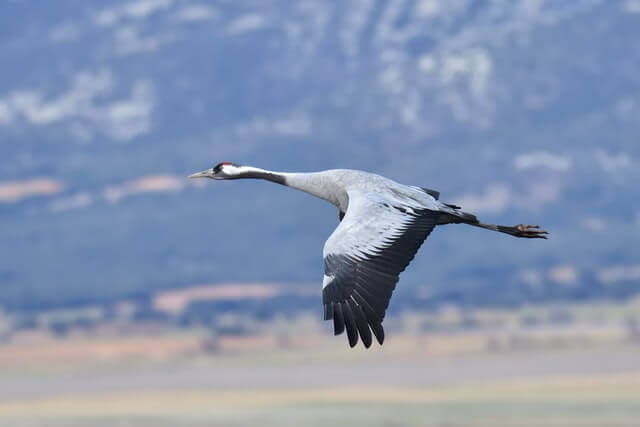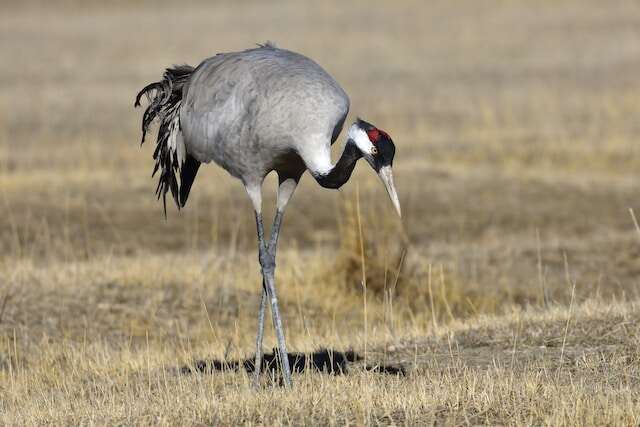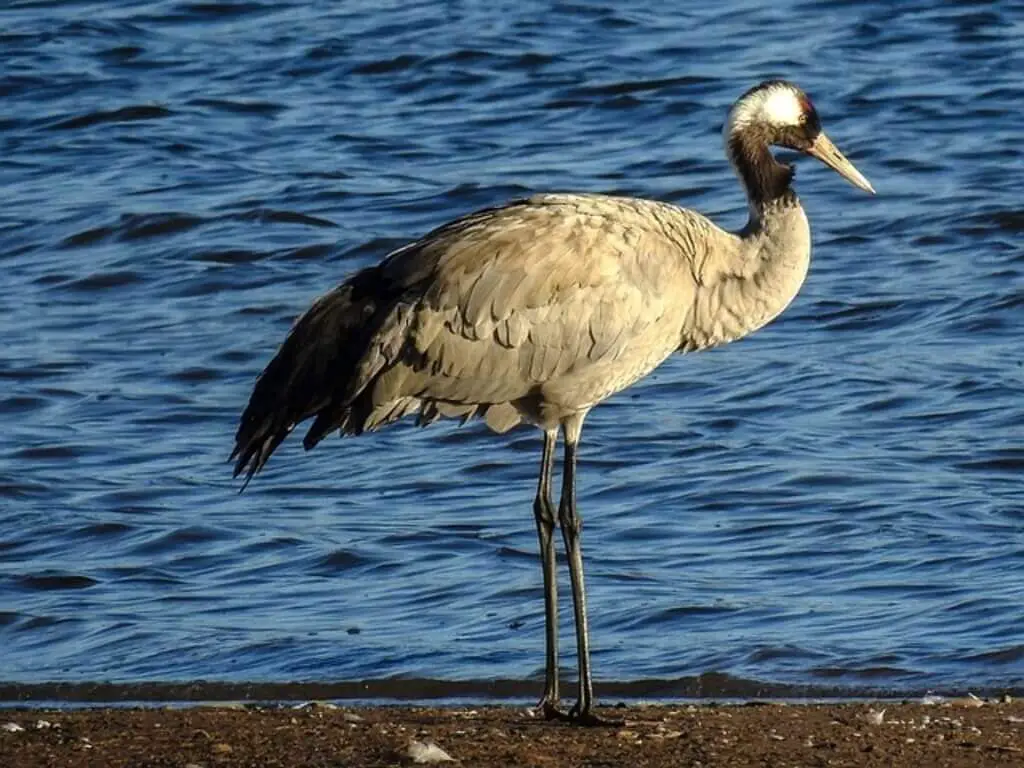Welcome to a world of wonder as we uncover 60 interesting facts about Common Cranes. From their majestic flights to their intricate behaviors, join us on a captivating journey of discovery into the realm of these magnificent birds.
Common Crane (Overview)

Interesting Facts About Common Cranes
| Characteristics | Description |
|---|---|
| Identification | The Common Crane is approximately 3.3 – 4.3 feet long and weighs between 6.6 to 13 pounds. They boast a wingspan of over 7 feet and feature gray plumage with a distinctive black-and-white head pattern, a red crown patch, and a tousle of tail feathers. These elegant birds possess exceptionally long necks and legs, along with long yellow bills, and black legs and feet. |
| Adult Length | 3.3 – 4.3 feet (39–51 inches). |
| Adult Weight | 6.6 – 13.0 lbs. (105.6-208 oz.). |
| Wingspan | 5.8 – 7.9 feet (70–95 inches). |
| Taxonomy | Kingdom: Animalia, Phylum: Chordata, Class: Aves, Order: Gruiformes, Family: Gruidae, Genus: Grus, Species: G. grus, Binomial Name: Grus grus, Scientific Name: Grus grus. |
| Range | Common Cranes are commonly found in Eastern Europe and Asia, with additional populations in Western Europe, Africa, and North America. The largest populations inhabit China, Mongolia, and Siberia, with smaller numbers elsewhere. |
| Migration | These migratory birds travel to India, Southeast Asia, the Tibetan Plateau, and parts of North Africa for wintering. |
| Habitat | The majority of Common Cranes reside year-round in Central Asia, particularly near rivers, bogs, grassy fields, lakes, marshes, and other wetlands for breeding purposes. |
| Diet | Their diet includes seeds, roots, aquatic plants, insects, amphibians, crabs, snails, earthworms, millipedes, spiders, woodlice, rodents, and small birds. |
| Global Extent of Occurrence | Less than 20,000 km2 (7722.0432 sq mi). |
| Population | Global Population: Estimated 490,000-505,000 individuals. European Population: Estimated 225,000-370,000 individuals. |
| Conservation Status | Listed as Least Concern (Population Increasing). |
| Lifespan | In the Wild: 20 years of age; In Captivity: 43 years of age. |
| Breeding Period | April to June. |
| Incubation Duration | 28 to 31 days. |
| Chicks Fledge | 65–70 days. |
| Clutch Size | 1–4 eggs. |
| Egg Color | Light brown or yellowish-green eggs with rust-colored spots. |
| Nesting Habits | Both sexes collaborate in building the nest, which is a mound of vegetation, typically on the ground or near water bodies. It’s constructed from reeds and grasses collected by the cranes. They may also reuse old nest sites. Incubation is carried out by both parents, and the eggs hatch after 28 to 32 days. Chicks have cinnamon brown plumage that matures into gray. They fledge at approximately 60 to 70 days and reach full maturity in four to six years. |
- Molt and Flight: Adult cranes experience a remarkable process called molting, which occurs every few years before migration. During this period, they shed their old feathers and grow new ones. This transformation leaves them temporarily flightless, lasting up to six weeks, until their new feathers fully develop, allowing them to soar through the skies once again.
- Common Crane Alias: The Common Crane, scientifically known as Grus grus, goes by another name, the Eurasian Crane. This elegant bird is well recognized for its striking appearance and is found across various regions, earning it these two common names.
- Incredible Migration: Cranes are celebrated for their extraordinary migratory journeys, covering impressive distances of up to 13,000 miles each year. These remarkable travels span across continents and showcase their adaptability and endurance in the face of diverse landscapes and climates.
- Lifespan Variance: The Common Crane exhibits a significant disparity in its lifespan between the wild and captivity. In their natural habitat, they typically live for about 20 years, while those in captivity can thrive for an astonishing 43 years. This divergence highlights the impact of environmental factors on their longevity.
- Lifelong Bonds: Cranes are known for their deep sense of commitment when it comes to forming partnerships. They engage in monogamous relationships and establish long-term pair bonds that often endure for life. In the event of a partner’s demise, they display resilience by seeking new companions within their social circle or neighboring groups.
- Nesting Expertise: When it comes to parenting, cranes exhibit exceptional nesting skills. They construct spacious nests crafted from twigs and leaves to ensure the safety and comfort of their eggs. This demonstrates their meticulous attention to detail and care for their offspring.
- Social Cohesion: Cranes are highly social creatures when not breeding, and often congregating in large flocks. These gatherings emphasize their strong sense of community and the importance of social interaction within their species.
- Graceful Gait: Cranes are not just elegant in the air; they also exhibit gracefulness on land. Their long legs and deliberate strides make them look remarkably poised and elegant as they traverse various terrains.
- Aquatic Wading: Their long legs serve a dual purpose. In addition to enhancing their graceful walking, these extended limbs allow them to wade through shallow waters with ease. This adaptation aids them in capturing aquatic prey.
- Tree Perching: Unlike some other bird species, cranes do not possess the physical adaptations necessary for perching in trees. One significant limitation is their lack of a long back toe, which is essential for gripping branches, leading them to favor other resting places.
- Impressive Flight: The Common Crane’s flight capabilities are awe-inspiring. They can reach horizontal speeds of 25-35 mph, showcasing their agility and power in the air. Their broad wingspan, which can extend up to 8 feet, facilitates their remarkable flights.
- High-Altitude Pioneers: As the world’s second highest-flying birds, Common Cranes have been observed crossing the Himalaya mountains at astonishing altitudes of up to 33,000 meters. This remarkable feat illustrates their adaptability to extreme conditions during migration.
- Territorial Behavior: Cranes are fiercely territorial birds, especially when it comes to securing mates and nesting areas. Their disputes with other cranes highlight their determination to protect their territories and ensure successful reproduction.

- Incredible Seasonal Migration: Common Cranes embark on remarkable seasonal migrations, traveling from their breeding grounds in northeast Asia to winter in India, and then returning to their northern habitats in the spring. These long journeys highlight their adaptability and navigational prowess over vast distances.
- Endangered Range: Historically, Common Cranes thrived in wetlands spanning Europe and extending into northern Africa. However, their range has significantly dwindled, leading to their classification as an endangered species across much of their once-vast territory. This decline underscores the importance of conservation efforts.
- Diverse Diet: Common Cranes exhibit a versatile diet primarily consisting of insects and various invertebrates, including beetles and dragonflies. However, they are not limited to solely animal-based nutrition and will also consume plant material when available.
- Feathers for Courtship: While the wing feathers of cranes facilitate flight, they serve a dual purpose as a visual spectacle during courtship. These feathers are used to attract potential mates, emphasizing their significance in the crane’s breeding rituals.
- Nest Building: Although cranes are known to construct their nests, they occasionally opt to reuse abandoned nests from other large birds such as swans or geese. This resourceful behavior showcases their adaptability and ability to make the most of their surroundings.
- Vocal Communication: Cranes are renowned for their vocal repertoire, emitting a range of sounds including moans, hisses, and honks. These vocalizations can carry for impressive distances, reaching up to 2 miles away, serving various communicative purposes within the crane community.
- Egg Laying and Fledging: Female cranes typically lay a clutch of 1 to 4 eggs, which incubate for approximately 28 days before hatching. Once the chicks emerge, they undergo a fledging period lasting 60 to 70 days. During this time, the young cranes remain reliant on parental care until they achieve independence.
- Dedicated Pair Bonds: Crane pairs exhibit unwavering commitment, maintaining their bonds throughout the entire year. The only instances of separation occur during migration or when the female is engaged in egg incubation or chick rearing. This loyalty underscores their cooperative approach to parenting.
- Swimming Adaptability: While cranes do not possess webbed feet, they are surprisingly adept swimmers. This adaptability enables them to navigate water bodies, adding to their ecological versatility.
- Global Migration Routes: The majority of cranes are concentrated in Eastern Russia, Siberia, and Mongolia. However, their migratory patterns also extend to parts of North America during the autumn season. This highlights the expansive geographic scope of crane migrations.
- Varied Habitat Preferences: Common Cranes display remarkable adaptability in terms of their preferred habitats. They can be found in a range of environments, including wet or dry grasslands, marshes, and wetlands, showcasing their capacity to thrive in diverse ecosystems.
- Epic Migrations: One of the most captivating aspects of Common Cranes is their massive migrations. During their breeding season from May to July, they embark on some of the world’s largest migrations, traversing thousands of miles from Northern Canada to Siberia. This awe-inspiring journey showcases their endurance and navigational skills.
- Nonstop Flight: Cranes exhibit incredible stamina during migration, often flying nonstop for extensive distances. In a single day, they may cover up to 250 miles without pausing, emphasizing their remarkable endurance and determination.
- Nocturnal Migration: To evade potential predators, Eurasian Cranes have been observed migrating at night. This nocturnal behavior underscores their ability to adapt and ensure their safety during their arduous journeys.
- Elaborate Courtship Dances: Cranes are known for their intricate courtship displays, which often involve synchronized dances, intricate postures, and vocalizations. These displays serve to strengthen pair bonds and communicate readiness for breeding.
- Distinctive Plumage: While many crane species exhibit primarily gray or white plumage, they are often distinguished by unique features such as red crowns, facial markings, and ornate feather patterns, adding to their visual appeal.

- Agile in Flight: Despite their large size, cranes are remarkably agile in the air. They can perform impressive aerial maneuvers, including soaring, gliding, and even acrobatic displays, showcasing their gracefulness in flight.
- Symbolism and Cultural Significance: Cranes hold special cultural significance in many societies. They are often seen as symbols of longevity, happiness, and good fortune. In Japanese culture, for example, the crane is associated with hope and healing.
- Cooperative Parenting: Both crane parents actively participate in rearing their young, sharing responsibilities such as incubation, feeding, and protection. This cooperative parenting approach enhances the chances of chick survival.
- Cranes as Ambassadors: Conservation efforts for crane species often extend beyond their own well-being. Protecting crane habitats and populations can have positive impacts on entire ecosystems, making cranes “umbrella species” that help safeguard a wide range of biodiversity.
- Threats to Crane Populations: Cranes face numerous threats, including habitat loss due to human development, pollution, climate change, and poaching. Conservation initiatives are crucial to ensuring the survival of these magnificent birds.
- Extraordinary Memory: Cranes are known for their remarkable memory, particularly when it comes to migration routes and nesting locations. This memory enables them to return to the same breeding and wintering grounds year after year.
- Adaptive Behavior: Cranes are highly adaptable birds, capable of adjusting their behavior and foraging strategies based on seasonal changes and environmental conditions. This adaptability enhances their survival in a variety of habitats.
- Crane Conservation Organizations: Numerous organizations and initiatives worldwide are dedicated to crane conservation, conducting research, habitat restoration, and educational programs to protect these iconic birds.



